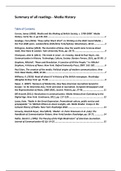Summary of all readings - Media History
Table of Contents
Curran, James (2002). Media and the Making of British Society, c. 1700-2000’. Media
History, Vol 8, No. 2, pp 135-154. ...................................................................................... 1
Sandage, Tom (2013). “How Luther Went Viral”. In: Writing on the Wall: Social Media –
the First 2000 years. London/New Delhi/New York/Sydney: Bloomsbury, 48-63 ................ 3
Pettegree, Andrew (2014). The Invention of New. How the world came to know about
itself. New Have & London: Yale University Press, pp. 58-75. ............................................. 4
Thompson, John B. (2011). ‘The trade in news’. In: Crowley, David & Paul Heyer, eds.
Communication in History. Technology, Culture, Society. Boston: Person, 2011, pp 95-99. . 5
Stephens, Mitchell. “News and Revolution. A Junction of All the People.” In: Mitchel
Stephens, A History of News. New York: Oxford University Press, 2007. 162-182. .............. 6
Paul Starr, The creation of the media. Political origins of modern communications. New
York: Basic Books, 2004, 32-46. ......................................................................................... 7
Williams, K. (2010). Read all about it! A history of the British newspaper. Routledge:
Abingdon & New York: pp. 75-98. ..................................................................................... 9
Høyer, S. (2007). ‘Rumours of Modernity. How New American Journalism Spread to
Europe.’ In: M. Broersma (ed.), Form and style in Journalism. European Newspapers and
the Representation of News, 1880-2005, Leuven: Peeters, pp. 27-46................................ 11
Bill Kovarik (2011). Revolutions in communication. Media History from Gutenberg to the
Digital Age. New York: Continuum, 2011, pp. 117-129..................................................... 12
Lacey, Kate. “Radio in the Great Depression. Promotional culture, public service and
propaganda.” In: Michele Hilmes an Jason Loviglio, eds. Radio Reader. Essays in the
Cultural History of Radio. New York: Routledge 2002. ..................................................... 13
Corwely, David & Heyer, Paul (2013). ‘Media’. In: Peter Simonson et al. (eds). The
Handbook of Communication History. New York/London: Routledge, pp. 58-72. ............. 14
Hallin, Daniel C. (1992). The Passing of the High Modernism” of American Journalism.
Journal of Communication 42 (3): 14-25. ......................................................................... 15
,Curran, James (2002). Media and the Making of British Society, c.
1700-2000’. Media History, Vol 8, No. 2, pp 135-154.
3 problems Media History:
1. Medium history: It takes the form of historical accounts of an individual medium.
This subdivision gives rise to fractured and incomplete understandings of the
historical role of the media.
2. Media centricity. focusing on one aspect, illuminates links between media and
development and wider trends in society. E.g. film studies is mainly preoccupied with
content and radio broadcasting with institutional development.
3. Technological determinism: too much attention on technology, too little on content
and process
6 interpretations:
1. Liberal interpretation
The central thesis of liberal media historians is that this process of democratization
was strengthened by the rise of the mass media.
3 claims:
- the mass media became independent of government control in mid 19th century
- free media empowered the people.
-the press contributed to the expansion of the political community
3 liberal interpretations:
- the press became independent not only from government but also from party and
social interest, enabling it to become the voice of the people, and hold government
to account
-press = the vehicle of dynamic social groups who pressed for an extension of
democracy
- the press = a forum of debate enabling society to commune with itself in the
context of continuity and gradual change
➔ common = press as servant of maturing democracy
Broadcasting enhanced democracy by improving communication within the political system.
Defect of this view: public excludes women.
It assumes that media became the voice of the people, when they were sometimes elite and
patriarchal influence.
2. Feminist interpretation: 17th and 18th century: women inferior to men, supported by
popular culture. Improved at the end of 20th century.
➔ Protests, response of improvements in 18th century.
Two views:
-traditionalists: women’s inherited characteristics makes them inferior and suited for
home, while men’s characteristics are for external world: women’s journalism
developed along these lines.
-> improvements from 1918, but women’s culture still assigned to traditional
gender-roles. When women started working more, and feminism from 1960s:
culture developed as well.
1
, Defect of this view: exludes men.
3. Populist interpretation: the media became more responsive to the preferences of
the people, and consequently generated greater pleasure and contentment.
➔ Focuses mainly on entertainment for people, previously denied by elite.
Two narratives: celebratory account of consumerism
and: decline in authority and power of elites: either anti-populism and anti-
democratic, or wants to raise cultural standards: libraries, popularization of daily
press -> democratization of print.
During second world war: maintain morale, more entertainment.
➔ Media, e.g. BBC, became less elite
Defect of this view: it tends to valorize market success at the expense of a more
adequate understanding of cultural value, and fails to distinguish aspects of equality
4. Libertarian interpretation
De-Christianization, individualism -> moral plurism. Struggle between traditionalists
and liberals e.g. when it came to representation of homosexuality in media.
Defect of this view: attacks social traditionalism rather than try to understand it
5. Anthropological interpretation: national identities.
In Britain: from 1700, Protestant view -> imperialism -> 19th century: nationalist
superiority.
➔ British national identity changed because of immigration: new ways to be British,
new minorities in media. Media promoted British unity.
Defect of this view: merely record how the media offered a changing construction of
the nation without relating this to wider ideological contests in society.
6. Radical Narrative: reassertion of elite control
The market and the state constituted a dual system of control.
According to Habermas, public sphere going from rational-critical to degeneration
because of the media = the ‘refeudalisation’ of society.
➔ Support for radical culture undermined by capitalist market.
In press: by growing costs, advertising and oligopoly
o Media is influenced by the dominant thought
Defect of this view: pays too little attention to class and gender-based movements
for change.
2




